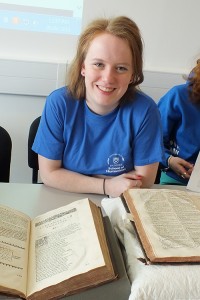 I am an exchange student from northern British Columbia, Canada, and will be returning home to finish my degree in September. I hope to have an eventual career in either archive or museum studies, so this course was perfect for me. I really enjoyed working with all this incredible material, as seeing as Canada is still a relatively new country, we do not have much of this sort of thing in our archives.
I am an exchange student from northern British Columbia, Canada, and will be returning home to finish my degree in September. I hope to have an eventual career in either archive or museum studies, so this course was perfect for me. I really enjoyed working with all this incredible material, as seeing as Canada is still a relatively new country, we do not have much of this sort of thing in our archives.
Lexicon anglo-graeco-latinum Novi Testamenti; or, A complete alphabetical concordance of all the words contained in the New Testament, both English, Greek, and Latin (1658)
Brechin Collection UQ 225.2
The object from the Brechin collection that I will discuss today is essentially a dictionary of words from the New Testament, with translations of the words in three different languages. Since it gives examples of how words or phrases were used in the Bible, it must have been a handy reference tool for ministers and priests.
The Lexicon explains how words and phrases were defined and understood in the 17th century. The “Lexicon” also gives us an insight into the phenomenon of information overload. The dictionary was created to combat this problem. However, the cure may have been worse than the ailment. The Lexicon contains a wealth of information, i.e. multiple lists of words and phrases alphabetized in English, Greek and Latin, respectively.
Lord William of Sterling, Recreations with the Muses (1637)
Brechin Collection UQ 821.39
This Brechin Collection object is a collection of poems and tragedies, containing inter alia “The Tragedy of Julius Caesar” and the “Twelve Hours of Doomsday.” The book is a fine example of literary works in the Brechin Collection, of which there are few.
“Recreations with the Muses” shows us the literary tastes of inhabitants of the British Isles in the 17th century. Clearly, the Roman and Greek classics were highly valued, seeing as how all the tragedies revolve around heroes of ancient times. This book ties in with the grammar school education enjoyed by gentlemen at the time. It can be used to study education and literacy in the 17th century, as well as the culture of the time. And, I’ll be honest; it’s just a really fun read!

Comments are closed.